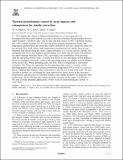Thermal perturbations caused by large impacts and consequences for mantle convection
Author(s)
Zuber, Maria; Watters, Wesley A.; Hager, Bradford H
DownloadZuber_Thermal perturbations.pdf (1.378Mb)
PUBLISHER_POLICY
Publisher Policy
Article is made available in accordance with the publisher's policy and may be subject to US copyright law. Please refer to the publisher's site for terms of use.
Terms of use
Metadata
Show full item recordAbstract
We examine the effects of thermal perturbations on a convecting layer of incompressible fluid with uniform viscosity in the limit of infinite Prandtl number, for two upper boundary conditions (free- and no-slip) and heat sources (100% volumetric heating and 100% bottom heating) in 2-D Cartesian finite element simulations. Small, low-temperature perturbations are swept into nearby downflows and have almost no effect on the ambient flow field. Large, high-temperature perturbations are rapidly buoyed and flattened, and spread along the layer's upper boundary as a viscous gravity current. The spreading flow severs and displaces downwellings in its path, and also thins and stabilizes the upper thermal boundary layer (TBL), preventing new instabilities from growing until the spreading motion stops. A return flow driven by the spreading current displaces the roots of plumes toward the center of the spreading region and inhibits nascent plumes in the basal TBL. When spreading halts, the flow field is reorganized as convection reinitiates. We obtain an expression for the spreading time scale, t [subscript s] , in terms of the Rayleigh number and a dimensionless perturbation temperature (Θ), as well as a size (Λ), and a condition that indicates when convection is slowed at a system-wide scale. We also describe a method for calculating the heat deposited by shock waves at the increased temperatures and pressures of terrestrial mantles, and supply estimates for projectile radii in the range 200 to 900 km and vertical incident velocities in the range 7 to 20 km s[superscript −1]. We also consider potential applications of this work for understanding the history of early Mars.
Date issued
2009-02Department
Massachusetts Institute of Technology. Department of Earth, Atmospheric, and Planetary SciencesJournal
Journal of Geophysical Research Planets
Publisher
American Geophysical Union (AGU)
Citation
Watters, W. A., M. T. Zuber, and B. H. Hager. “Thermal Perturbations Caused by Large Impacts and Consequences for Mantle Convection.” Journal of Geophysical Research 114.E2 (2009). ©2012 American Geophysical Union
Version: Final published version
ISSN
0148-0227